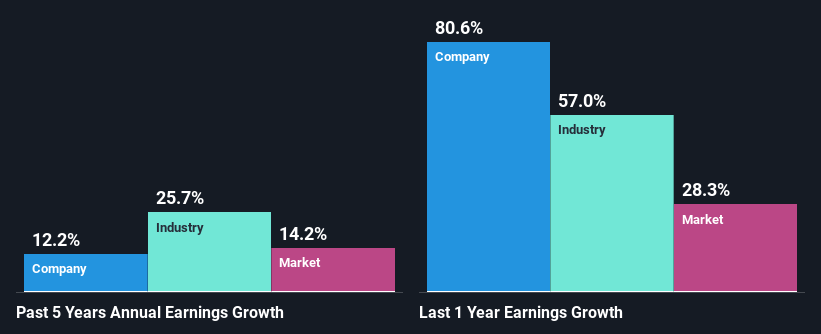Sandfire Resources Limited's (ASX:SFR) Stock Is Going Strong: Have Financials A Role To Play?
Most readers would already be aware that Sandfire Resources' (ASX:SFR) stock increased significantly by 12% over the past month. We wonder if and what role the company's financials play in that price change as a company's long-term fundamentals usually dictate market outcomes. Particularly, we will be paying attention to Sandfire Resources' ROE today.
Return on Equity or ROE is a test of how effectively a company is growing its value and managing investors’ money. Simply put, it is used to assess the profitability of a company in relation to its equity capital.
View our latest analysis for Sandfire Resources
How Do You Calculate Return On Equity?
Return on equity can be calculated by using the formula:
Return on Equity = Net Profit (from continuing operations) ÷ Shareholders' Equity
So, based on the above formula, the ROE for Sandfire Resources is:
8.7% = US$134m ÷ US$1.5b (Based on the trailing twelve months to December 2021).
The 'return' is the income the business earned over the last year. Another way to think of that is that for every A$1 worth of equity, the company was able to earn A$0.09 in profit.
What Has ROE Got To Do With Earnings Growth?
We have already established that ROE serves as an efficient profit-generating gauge for a company's future earnings. Depending on how much of these profits the company reinvests or "retains", and how effectively it does so, we are then able to assess a company’s earnings growth potential. Assuming everything else remains unchanged, the higher the ROE and profit retention, the higher the growth rate of a company compared to companies that don't necessarily bear these characteristics.
A Side By Side comparison of Sandfire Resources' Earnings Growth And 8.7% ROE
At first glance, Sandfire Resources' ROE doesn't look very promising. A quick further study shows that the company's ROE doesn't compare favorably to the industry average of 16% either. Although, we can see that Sandfire Resources saw a modest net income growth of 12% over the past five years. So, the growth in the company's earnings could probably have been caused by other variables. For example, it is possible that the company's management has made some good strategic decisions, or that the company has a low payout ratio.
As a next step, we compared Sandfire Resources' net income growth with the industry and were disappointed to see that the company's growth is lower than the industry average growth of 26% in the same period.
Earnings growth is a huge factor in stock valuation. The investor should try to establish if the expected growth or decline in earnings, whichever the case may be, is priced in. By doing so, they will have an idea if the stock is headed into clear blue waters or if swampy waters await. If you're wondering about Sandfire Resources''s valuation, check out this gauge of its price-to-earnings ratio, as compared to its industry.
Is Sandfire Resources Making Efficient Use Of Its Profits?
With a three-year median payout ratio of 38% (implying that the company retains 62% of its profits), it seems that Sandfire Resources is reinvesting efficiently in a way that it sees respectable amount growth in its earnings and pays a dividend that's well covered.
Besides, Sandfire Resources has been paying dividends over a period of eight years. This shows that the company is committed to sharing profits with its shareholders. Based on the latest analysts' estimates, we found that the company's future payout ratio over the next three years is expected to hold steady at 35%. Still, forecasts suggest that Sandfire Resources' future ROE will drop to 5.9% even though the the company's payout ratio is not expected to change by much.
Conclusion
In total, it does look like Sandfire Resources has some positive aspects to its business. Specifically, its fairly high earnings growth number, which no doubt was backed by the company's high earnings retention. Still, the low ROE means that all that reinvestment is not reaping a lot of benefit to the investors. That being so, according to the latest industry analyst forecasts, the company's earnings are expected to shrink in the future. To know more about the company's future earnings growth forecasts take a look at this free report on analyst forecasts for the company to find out more.
Have feedback on this article? Concerned about the content? Get in touch with us directly. Alternatively, email editorial-team (at) simplywallst.com.
This article by Simply Wall St is general in nature. We provide commentary based on historical data and analyst forecasts only using an unbiased methodology and our articles are not intended to be financial advice. It does not constitute a recommendation to buy or sell any stock, and does not take account of your objectives, or your financial situation. We aim to bring you long-term focused analysis driven by fundamental data. Note that our analysis may not factor in the latest price-sensitive company announcements or qualitative material. Simply Wall St has no position in any stocks mentioned.

 Yahoo Finance
Yahoo Finance 
